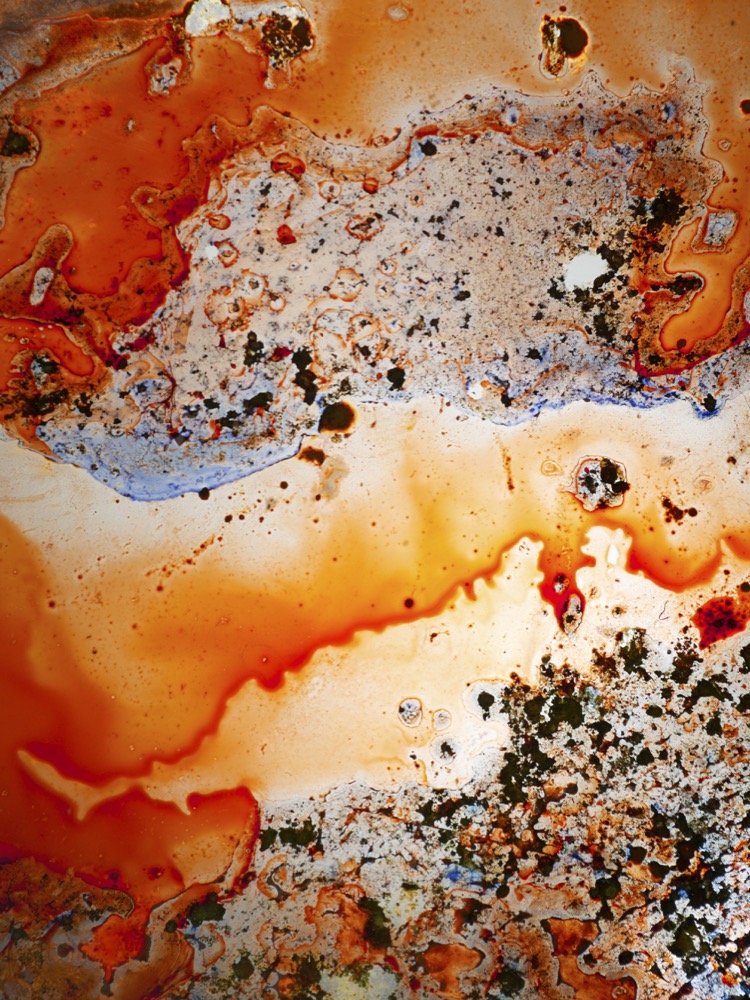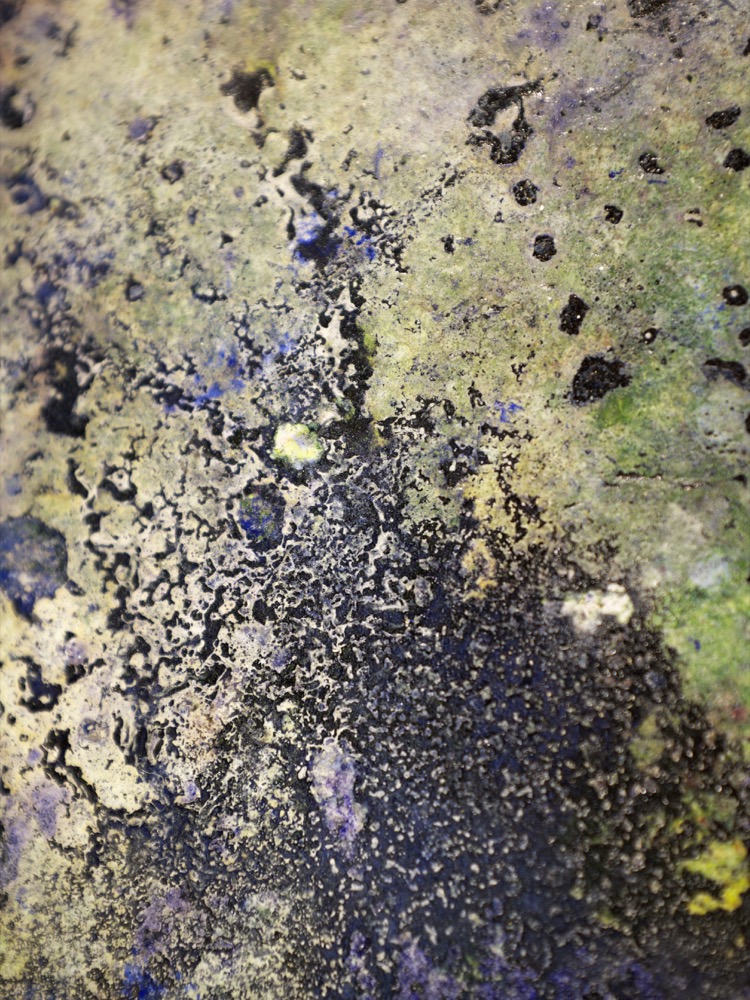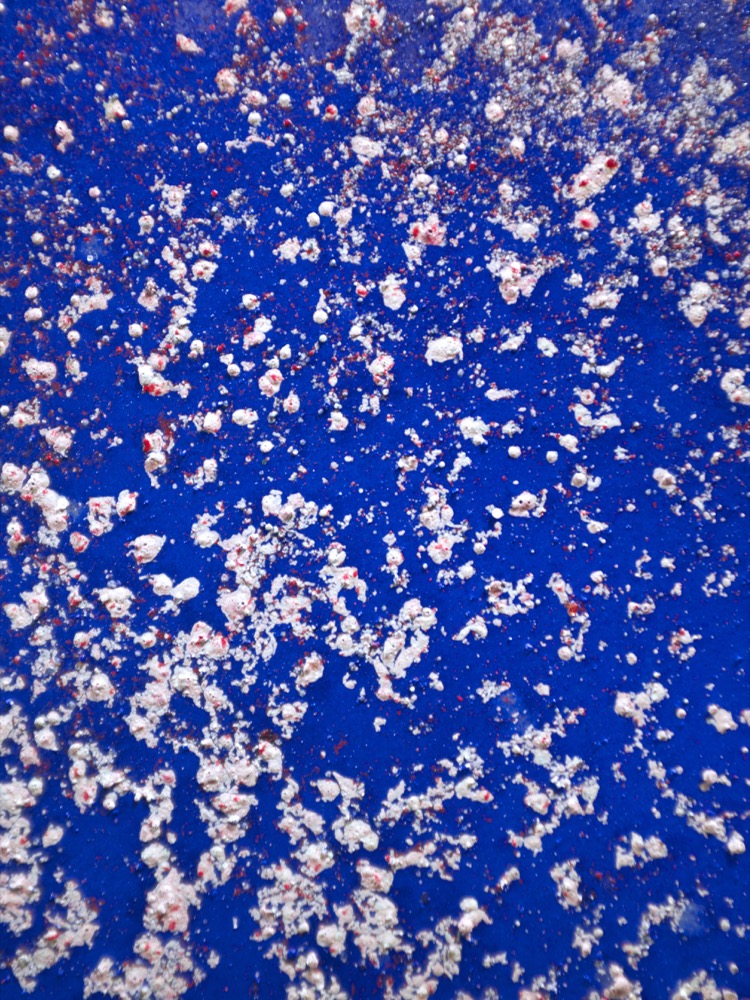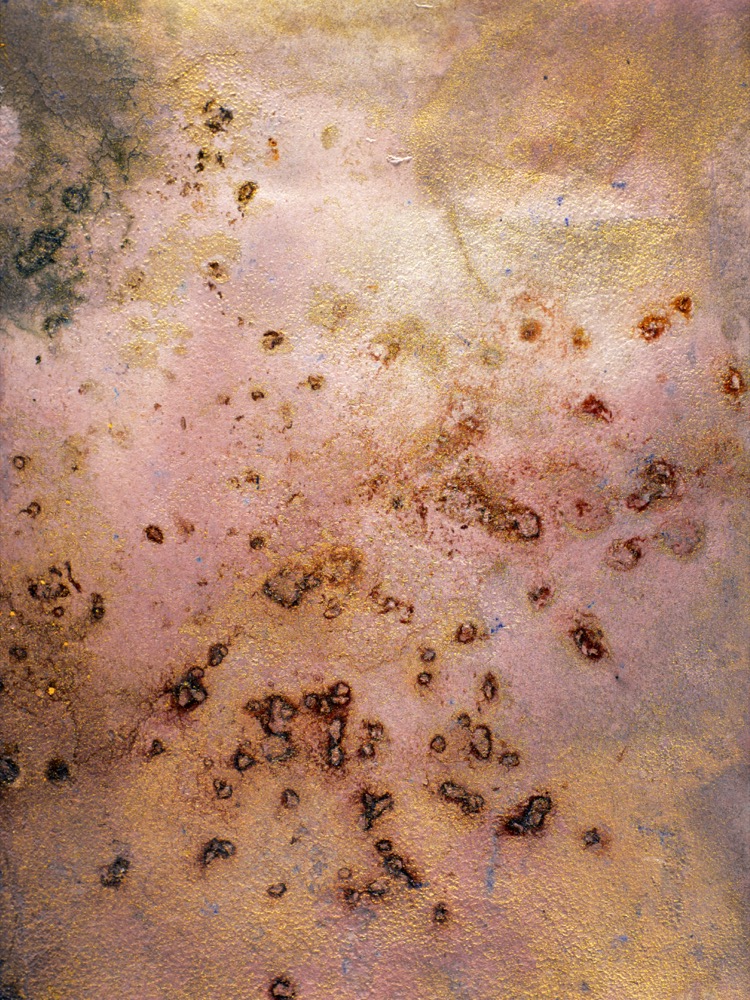Gasps ○ Forgetting ○ Fooled, 2013-2023
Oil, acrylic and household paints, ink, dye, pigment, lacquer, salt, sand and sugar on canvas. Various sizes.
Botanical Magic, 2019
with Deiniol Williams and Lindsey Loughtman
Grid of 144 backlit antique glass magic lantern slides from the Manchester Museum botanical collection. The images show seeds, cells, zoophytes, landscapes, diatoms, cotton production, teaching models, and real and artificial plants including cocoa beans, breadfruit, water lilies, palms and ferns.
Gathering, 2022
Collage on perspex, 70cm x 54cm. Collection of Renaissance-era (1435-1515) painted fabric drapes and folds. When does an image becomes ‘abstract’? What gets included and what gets omitted from the histories we share?
Half Corner ○ Heft ○ Offering, 2011-2021
Oil, acrylic, salt, sand and sugar on canvas. Each panel: 23cm x 31cm. Layered triptych painting created over 10 years including through periods of exposure to rain, snow and sun. Each new layer obscures the preceding but retains vestiges of the underlying compositions.
Oozy, 2020
As ARM with Navid Asghari and David Rogerson. Three channel film and sound installation. Staged at The Holden Gallery. Curated by Zoe Watson.
That Sinking Feeling, 2018
With ARM. Installation, film, sound and sculpture.
‘Oumuamua, the first known interstellar object to pass through our solar system, moves past the earth, cold to the existential crisis facing the planet’s inhabitants. The scout from afar is strange, as are we. In fact, as we race to understand more, we become even stranger, and so do the objects and phenomena we encounter. The search for understanding and technological advancement has led to what many consider to be a new epoch in the history of the Earth—the Anthropocene. That Sinking Feeling seeks to reflect our current predicament, the artefacts we create in our pursuit of progress, imagined futures (that may or may not contain us) and the complex emotional states we find ourselves in. ARM is a UK-based, cross-disciplinary arts practice comprising Navid Asghari, David Rogerson and James Moss.
Neo Me, My Sister, 2020
with Linjie Qu, prints. Each 59cm x 81cm
The lyrics of nine songs, well-known across generations and continents, consecutively software-translated into seven randomly selected languages and then back into English
Heartwarmer Dimmer, 2022
Floor-to-ceiling animated film, 8,836 colour blocks in 16 permutations
Second Nature, 2019
with Navid Asghari
Recent studies have shown that not only do nature sounds (birdsong, trickling water, wind among trees) induce positive brain activity and reduce stress, but artificial, simulated nature sounds also have beneficial effects. For Second Nature: What is “nature” anyway?, Portico Library staff and volunteers built a grotto of synthetic flowers and foliage for visitors to relax in where speakers played real-life and synthesized nature sounds created by composer and artist Navid Asghari. Re-introducing sounds previously absent from the city centre venue, this installation invited visitors to consider ideas of authenticity and artificiality and what we mean by “natural” and “unnatural”. The real-life audio elements included field recordings from Rae Story’s Breathing Spaces project with TLC Saint Luke’s, which maps Manchester’s tranquil spaces for people experiencing mental health problems and emotional distress.
Lucky Me, ARM, 2016
with Navid Asghari and David Rogerson
Gallery 1
First, visitors enter a partitioned, brightly lit area–a kind of ma (間)–before progressing into a second, darkened space containing a large, circular, knee-high pool of mud. Focused light from above picks out the pool, revealing the top of a small spherical object half-submerged in the centre and occasional bubbles appearing on the surface.
Gallery 2
A screen opposite the gallery reception shows a collection/montage of archive film clips and images of mud in ritual, farming, disaster etc. Via a simple tracking setup, visitors can scrub back and forth through the footage using simple gestures.
Windows
The gallery windows are coated externally with mud, replenished and altered each day as a living, evolving artwork that brings the outside of the building into the exhibition space.
Drag Line ○ Tread Finely, Finally ○ Fell Handle ○ Smoulder, 2015
Oil, acrylic and household paints, ink, dye, pigment, salt, sand, sugar and lacquer on canvas/paper/cellophane. Diameter 20cm.
The Living And The Dead Know All There Is To Know About Living And Dying, 2015
Collaboration with portrait subjects documented in sets of three photos.
Photo A: Time, The River, the subject is alive at the time of the photo being taken, but no longer alive at the time of exhibition.
Photo B: Still, the subject is not alive at the time of the photo being taken or at the time of exhibition.
Photo C: Tempting Fate, the subject is alive at the time of the photo being taken, and at the time of exhibition.
The form of the work depends on subjects’ involvement and is delivered at an unknown future time, determined by events.





Feint, 2015
with Chan-yang Kim, book
“Feint draws from a wide array of conceptual influences, from the tempting immersions of Roger Hiorns to Ernesto Neto’s attempts to connect the interior and exterior, and Tacita Dean’s projections and landscapes – the works position painting within a cinematic context, oversized and animated. As with Cindy Sherman’s desire to “make something out of the culture”, Moss’s work examines itself – the viewing is disrupted by the constantly changing light, the artifice slips.” – Fuse Art Space
“Moss has a preoccupation with the surface quality of his paintings; by using a range of paints and materials he forces a volatile meeting of colours resulting in a surface thick with reactions and unexpected collisions. This is one of the greatest joys of Moss’s paintings, they require of us (and reward!) the study of every corner of change and movement across the surface… each intersection of colour; each gradation of form.” – Susanna Caudwell
The 72-page book documenting James Moss's project at Fuse Art Space, Feint, features 100 photos of work from the exhibition by Chan-yang Kim, plus an essay on the work by Rowland Hill and an introduction by Sarah Faraday.
Untied States, text, 2014
100 entries from the Diagnostic and Statistical Manual of Mental Disorders, software-translated 3 times to create space for rethinking the vocabulary around psychology, mental health and emotional distress. A new version of Untied States formed the basis of a group project with 50 contemporary artists, each paired with one entry, in The Portico Library’s 2020 exhibition, Talking Sense: The changing vocabulary of mind and brain.
Speechless, painting series, 2010-14
oil, acrylic and household paints, ink, dye, pigment, salt, sand, sugar and lacquer on canvas
Nil (detail), six-hundred and twenty-five 8cm x 8cm (945px x 945px) digital paintings, 2004
Lapse, Stop-motion animation of shaken, hand-shredded drawings, paintings and texts on paper, created between 2001 and 2004.
Screened as part of an installation with a cascade of thousands of the original shredded fragments filling and overflowing from a vertical column of custom-built troughs.






















































